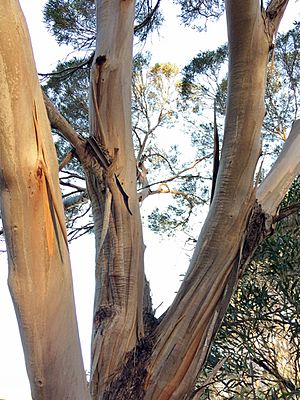Kangaroo Island narrow-leaf mallee facts for kids
Quick facts for kids Kangaroo Island narrow-leaf mallee |
|
|---|---|
 |
|
| Eucalyptus cneorifolia on Kangaroo Island | |
| Scientific classification | |
| Genus: |
Eucalyptus
|
| Species: |
cneorifolia
|
The Kangaroo Island narrow-leaf mallee (Eucalyptus cneorifolia) is a special type of tree that grows naturally on Kangaroo Island in South Australia. It's known for its thin, dark green leaves and is an important part of the island's plant life.
Contents
What Does It Look Like?
This mallee tree can grow to be about 5 to 10 meters (16 to 33 feet) tall. It usually grows straight up and can have one or many stems. At the bottom of its trunk, it has a special woody swelling called a lignotuber. This helps the tree regrow after fires.
The tree often has many thin, dark green leaves that form a thick top layer, called a canopy. If you look closely at the leaves, you can see tiny spots where oil is stored. The bark on the lower part of the trunk is rough and fibrous, usually greyish-brown to dark-grey. Higher up, the bark is smooth and grey.
The adult leaves are arranged alternately along the branches. They are long and narrow, like a spear or a ribbon, about 10 centimeters (4 inches) long and 1 centimeter (0.4 inches) wide. They are shiny, olive-green, but can look duller and grey-green when dry. Their veins are not very clear.
Flowers and Fruit
The Kangaroo Island narrow-leaf mallee flowers between December and April. It produces small white flowers that grow in groups called inflorescences. These flower groups are found where the leaves meet the stem, and each group has about 4 to 14 flowers.
The flower buds are usually shaped like an oval, with a cone-shaped or half-sphere-shaped cap. They are about 1 centimeter (0.4 inches) long and 0.5 centimeters (0.2 inches) wide.
After flowering, the tree produces fruits that are shaped like a half-sphere or a round ball. These fruits are about 0.7 to 0.8 centimeters (0.3 inches) long. Inside, they have brown, oval-shaped seeds that are slightly wrinkled. Each seed is about 2 millimeters (0.08 inches) long and 1 millimeter (0.04 inches) wide.
Naming the Mallee
The Kangaroo Island narrow-leaf mallee was first officially described by a botanist named Augustin Pyramus de Candolle in 1828. He published its description in a book called Prodromus Systematis Naturalis Regni Vegetabilis.
The scientific name cneorifolia comes from two parts:
- Cneorum: This is the name of another plant genus.
- folium: This is a Latin word meaning 'leaf'.
So, cneorifolia means "leaves like Cneorum", because its leaves look similar to those of an unrelated plant called Cneorum tricoccum.
Where Does It Grow?
This tree originally grew only on the eastern part of Kangaroo Island. It doesn't have many close relatives. You can also find it in areas around Adelaide and the Mount Lofty Ranges on the mainland of South Australia. However, it is considered vulnerable on the Fleurieu Peninsula, meaning it's at risk there.
The Kangaroo Island narrow-leaf mallee grows best in soils that drain water well, especially over rocky layers like laterite or limestone. It often grows as part of a thick shrubland community.
Uses and History
This tree is grown in special farms, called plantations, to produce cineole-based eucalyptus oil. This oil is used in many products, like medicines and cleaning supplies.
A long time ago, on Kangaroo Island, there were more than 100 places that used to make eucalyptus oil from this tree. This process is called distillation. However, after the 1930s, the oil-making business slowed down because sheep farming became more profitable. Today, there is only one distillery still working on the island.
Gallery
- Features of Eucalyptus cneorifolia
- Eucalyptus Oil Industry Revival, Landline, ABC. [1]
See also
 In Spanish: Mallee de hojas angostas de la Isla Canguro para niños
In Spanish: Mallee de hojas angostas de la Isla Canguro para niños






